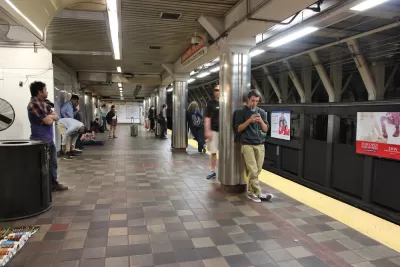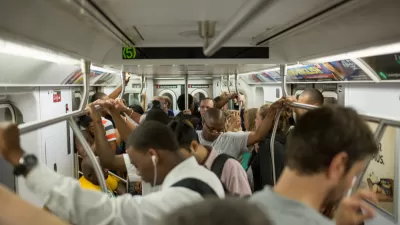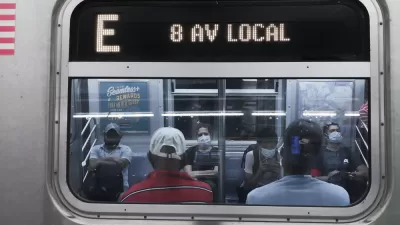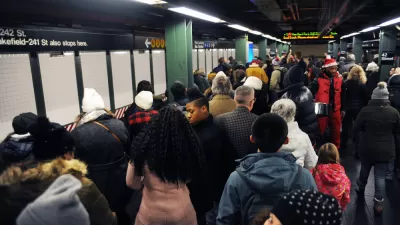With so much attention placed on the woes facing D.C. Metro, it's important to recognize that it is hardly the only subway facing critical infrastructure investment needs.

All three subway systems in Boston, New York, and Washington D.C. "need billions of dollars to replace aging infrastructure and to meet rising demand," writes Emma G. Fitzsimmons of The New York Times. The New York subway, opened in 1904, and Boston, opened in 1897, while considerably older than D.C. Metro, which opened a comparatively recent 1976, are three of the four busiest subways in the United States.
Chicago's subway, which includes the "L" which opened 1892, is the third busiest in the U.S, per Wikipedia, but it is not included in this piece.
Frequent disruptions have left riders stranded on trains and scrambling to make it to work on time. In the Washington area, people are preparing for widespread closings while repairs are made. In New York, Brooklyn residents are alarmed by the possibility of a yearlong shutdown of the L subway tunnel to Manhattan. In Boston, the crowded Red line is periodically upended by technical problems and other issues.
Fitzsimmons offers reasons why the three subways are so troubled, though she points out that they are not alone.
The Federal Transit Administration found that public transit systems have a backlog of $86 billion in critical maintenance nationwide. Officials pushed for infrastructure funding on Capitol Hill recently as part of Infrastructure Week, an annual series of events to highlight the issue.
Side note: Hillary Clinton promised on Wednesday that if elected president, she will act to fund infrastructure within 100 days, proposing to spend more than $275 billion.
While infrastructure problems are nothing new, Fitzsimmons points to specific weather-caused problems on two subway systems: Hurricane Sandy flooding caused problems with many tunnels, lines and stations in New York City, including the 'L' subway tunnel under the East River that will affect 400,000 riders beginning 2019, as well as Amtrak's Hudson River tunnels, and the epic snowfall last year in New England.
From Feb. 10, 2015, New York Times:
[T]he storms have exposed the vulnerabilities of the Massachusetts Bay Transportation Authority (MBTA), which operates the region’s decrepit, fitful subways, buses and commuter rail lines. The underfunded system, which carries 1.3 million people a day and is $5.5 billion in debt, has been plagued in the last 17 days by breakdowns, fires, power losses, delays of two and three hours, and scenes of commuters having to disembark and pick their way along snow-covered tracks.
Increasing ridership, with one notable exception
All three cities have seen population growth and remain top destinations for millennials, many of whom eschew driving a car. New York recently hit 8.5 million residents, while the Washington metropolitan area has grown to more than six million people and the Boston metropolitan area has topped 4.7 million.
As noted last month in "The Root Causes of the D.C. Metro Crisis":
Subway ridership, which increased annually for 13 years starting in 1996, is down 5 percent since 2010 and continues to fall, even as the region’s population grows. Metro has long blamed the decline on economic and social factors. But in October, for the first time, the agency acknowledged another reason: “the frequency of severe delays.”
Perennial Capital Plan Shortfalls
"The [MBTA] regional transit network has a $7 billion backlog of repairs that officials estimate could take more than two decades to eliminate," writes Fitzsimmons.
Last September, the New York State Comptroller's office indicated that the Metropolitan Transportation Authority faced a $9.8 billion funding gap in its five-year capital program
Asking the voters for help
Planetizen regularly covers transportation ballot measures, for both roads and transit, at the local, regional, or statewide level. On the local level, more often than not they take the form of sales tax measures, such as November's $120 billion measure in Los Angeles, or outliers like Missouri's cigarette tax ballot measure, also in November.
On the West Coast, the Bay Area Rapid Transit District (BART) may go to the ballot this November in the three counties in its district to fund its shortfall in basic infrastructure needs.
"The board is proposing a property tax measure to put before voters in Alameda, Contra Costa and San Francisco counties for a $4.5 billion bond," writes Joël Ramos, regional policy director for TransForm, an Oakland nonprofit, in an op-ed in the San Francisco Chronicle (may be subscription-only).
When did the operators of the three East Coast subways last go to the ballot to ask the region to pay for funds? Most transit systems nowadays regularly ask riders to pay more by boosting fares, but transit helps the entire region, not just those boarding buses and trains.
Hat tip to Kenyon Karl, Sierra Club transportation forum.
FULL STORY: Why Subways in the Northeast Are So Troubled

Alabama: Trump Terminates Settlements for Black Communities Harmed By Raw Sewage
Trump deemed the landmark civil rights agreement “illegal DEI and environmental justice policy.”

Study: Maui’s Plan to Convert Vacation Rentals to Long-Term Housing Could Cause Nearly $1 Billion Economic Loss
The plan would reduce visitor accommodation by 25% resulting in 1,900 jobs lost.

Planetizen Federal Action Tracker
A weekly monitor of how Trump’s orders and actions are impacting planners and planning in America.

Waymo Gets Permission to Map SF’s Market Street
If allowed to operate on the traffic-restricted street, Waymo’s autonomous taxis would have a leg up over ride-hailing competitors — and counter the city’s efforts to grow bike and pedestrian on the thoroughfare.

Parklet Symposium Highlights the Success of Shared Spaces
Parklets got a boost during the Covid-19 pandemic, when the concept was translated to outdoor dining programs that offered restaurants a lifeline during the shutdown.

Federal Homelessness Agency Places Entire Staff on Leave
The U.S. Interagency Council on Homelessness is the only federal agency dedicated to preventing and ending homelessness.
Urban Design for Planners 1: Software Tools
This six-course series explores essential urban design concepts using open source software and equips planners with the tools they need to participate fully in the urban design process.
Planning for Universal Design
Learn the tools for implementing Universal Design in planning regulations.
Caltrans
Smith Gee Studio
Institute for Housing and Urban Development Studies (IHS)
City of Grandview
Harvard GSD Executive Education
Toledo-Lucas County Plan Commissions
Salt Lake City
NYU Wagner Graduate School of Public Service





























